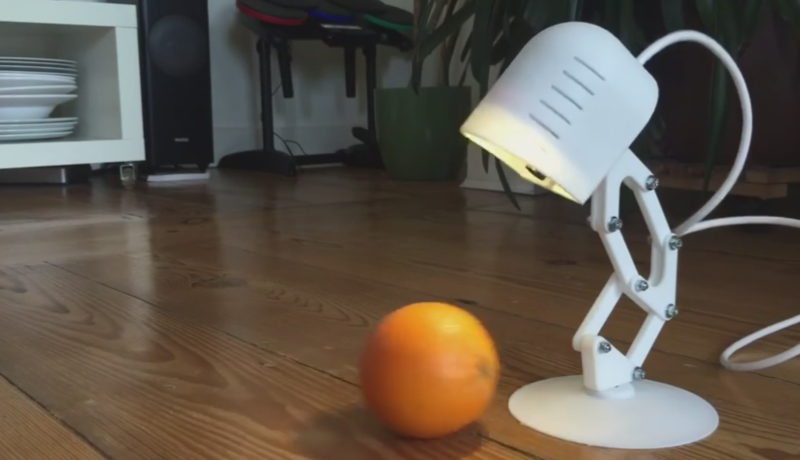Remember the Pixar lamp? Well, [Rick] from [Phlegmatic Prototyping] decided to build his own.
It’s actually the third iteration of the project, the first being made from a cheap camera sensor, an ATMega328, a computer mouse and laser cut parts. The second iteration… sounds like it was the Pixar Lamp — and due to possible copyright infringement [Rick] decided not to show it off. Which brings us to number three, Robolamp the Third.
Quite obviously not the Pixar lamp now, [Rick] designed the whole thing in 3D CAD and had it printed at Shapeways. It uses a CMUCAM5 vision sensor that detects color hues, allowing the lamp to track colorful objects, like an orange, which ends up looking painfully cute. Just take a look at the video.
He even designed the PCB from scratch and had it made from Dirt Cheap Dirty Boards. Which means the entire project is very reproducible — maybe if we ask nicely he’ll release the source files? We could use a Pixar Robolamp in the office!
UPDATE: [Rick] is planning on releasing the source for this! Will update with a link when available!
















Why 3d print the lower parts over laser cut? Material consistency?
Awwwww…. – Cuteness overload.
Next: Make it jump!
I’ll just leave this here:
https://www.youtube.com/watch?v=FFK_XuVqsCQ
Too cute indeed! I like how the first version was able to reach with it’s “neck”, also. I’d like to see that extra servo added back to this version.
I can see a (commercial) use for this: situations where hands are not free (i.e. dirty or must stay sanitary), and the work area moves a bit (i.e. surgery), set it to recognize ‘double taps’ to move the spotlight. It could also be stepped up a bit for theater, actor tracking.
Give actors an IFF-style transpoder or surgeons a head mounted designator. I think most use some sort of headlamp in combination with a large flood light though.
A simple IR beacon would be visible to the camer but not people. If you’re recording as well modern post processing would be able to remove IR artifacts if a good lens filter couldn’t be developed.
The real challenge will be having the light field *not* follow every movement all the time in the work area, which produces a jittery light field.
You don’t realize how much your head moves until you try to do something with a helmet camera. A headlamp produces a predictable light area (move your head and it follows, move your eyes and it doesn’t), while following actual hand or head movement is a lot like having a five year old shine the flashlight while you change a fuse in the dark – they do their best but the result is very distracting.
You could work with thresholds and variable speeds.
Simple dead-zone in the middle would ensure the light stays put while you are working in the same area. Stray too far from the middle and it will slowly start to adjust, and if you happen to reach the the outer edge it will ramp up and move much quicker.
It does not have to keep the target at dead center ;)
Awesome thinking.
Commercially your idea can be implemented on any lamp.
http://www.kittyhell.com/wp-content/uploads/2010/02/hello-kitty-pink-gun.jpg
Strap this to it and you’ed have the cutest sentry drone in the world!
I… I think I want to cuddle it, but it’s not… I really wanna cuddle it… I wanna coddle it… PIXAR!!!!!! *invokes Kirk*
MAKE IT HOP!!!
For some reason I was very confused. CMUcam5 = Pixy Camera.
“and due to possible copyright infringement [Rick] decided not to show it off.”
WTF? show that off! unless you plan on selling that particular version there is nothing they can go after you for. TBH I don’t know if you can copyright a standardized table lamp that through CGI is anthropomorphic.. can you..? Can I make/copyright an animated razorblade character that because it has a nameand presence I can sue any razor company that animates a razor floating around handlessly in CGI animations?
That we even have to consider these things, we are at an odd state of affairs these days indeed.
No kidding. I wanna see this second iteration too. Hell, if anything, that’s money in their pocket since they can just hire him out to run a production line of them for sale. You’re right, it is a sad state of affairs that businesses lack enough innovation that copyright becomes the money-maker for them.
Here you are: http://youtu.be/1vplL1Qeut0 – that one was printed with an SLA printer. It had some mechanical problems though.
That was really good. It even hopped a little. +1